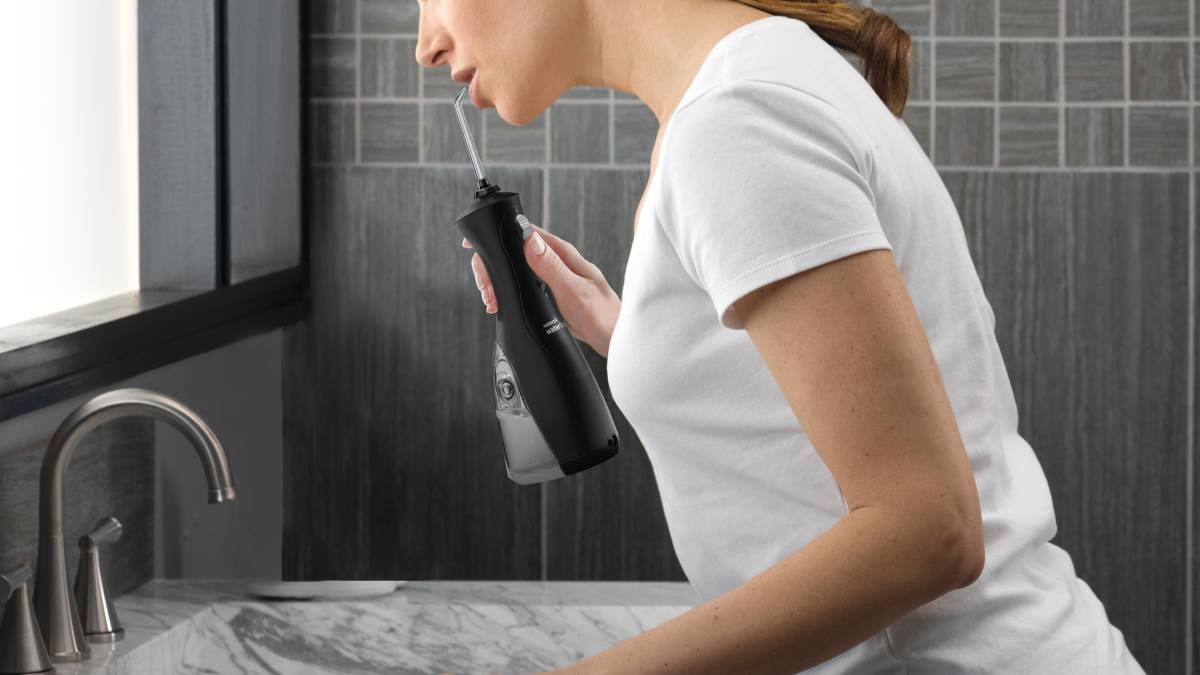The beauty tech industry thrives on hot new gadgets. From LED face masks to microneedling devices, the quest for a flawless appearance now goes way beyond a simple face cleanser and flannel routine.
But there’s one part of a good beauty regime that people often forget – and that’s looking after your teeth. More specifically, remembering to floss them.
Although we know we should floss twice a day, that doesn’t stop many of us from regularly skipping this step. After all, it’s a pretty fiddly and laborious task, plus after you’ve already spent a good 10 minutes scrubbing your face and brushing your teeth, who has the patience to then whip out the dental string?

That’s where water flossing comes in. Much like an electric toothbrush, these handheld devices are designed to do the hard work for you, using a small motor to send a blast of water from the tip and wash away plaque.
Water flossers have been around for a while now, but with celebrities and influencers jumping on the bandwagon, we asked Dr Jerome Sebah, founder of The Dentist Gallery, to explain everything you need to know.
How does a water flosser work?
Unlike regular string dental floss, these handy gadgets literally repel food and bacteria from the crevices of your teeth using water pressure. Think of it like a pressure washer for your teeth.
Using a water flosser can take a while to get used to, but once you get the hang of it, it’s a fairly simple process. “To use a water flosser, you need to place the tip of the device in your mouth, keep lips partially closed and lean over a sink,” explains Dr Sebah.
“Once you turn the power on, start from the back teeth and work towards the front, gliding along the gumline pausing briefly between teeth.
“Be sure to allow the water to empty from your mouth into the sink and don’t forget to floss both the front and back of your teeth, and continue until your mouth is clear.”
What are the benefits of flossing and what dental issues can it help prevent?
“Flossing is really important as it removes the plaque in between the teeth where brushing cannot reach,” explains Dr Sebah. Plaque is a soft, sticky film that builds up on your teeth and contains millions of bacteria.
If you don’t remove plaque after a few days, Dr Sebah warns that calcium from the saliva will precipitate the plaque into tartar, which can cause painful and expensive dental issues such as tooth decay and gum disease.
How is a water flosser better than traditional floss?
“Using a water flosser allows you to get into those areas of your mouth your normally can’t reach with string floss, meaning you can get a more thorough clean,” says Dr Sebah. “Plus, they’re also compatible with people with braces and are easy to use for those with veneers.”
Water flossers are said to be more effective at targeting plague. Dr Sebah, who is an ambassador for Waterpik, claims that the device can remove 99.9 per cent of plaque from treated areas, making it 50 per cent more effective for gum health compared to traditional string floss.
View this post on Instagram
String floss or water floss? Which should you choose? Visit our blog to compare.
If you’re concerned about the environment, water flossers are also a more sustainable option as they can be reused continuously opposed to single-use string floss and interdental brushes.
How often should we be water flossing?
Dr Sebah recommends using a water flosser in the evening for at least one minute to remove debris and plaque, “so it does not sit in the mouth overnight when the saliva flow is reduced”.
He adds: “The key point is to water floss daily to disrupt or remove the plaque every 24 hours so it does not mature. You can complete your daily floss, however, whenever it’s convenient for you.”
Do you use a water flosser? Do you find it more convenient than traditional flossing? Let us know in the comments section below.
Also read: Could you be damaging your tooth enamel without even knowing it?
– With PA

